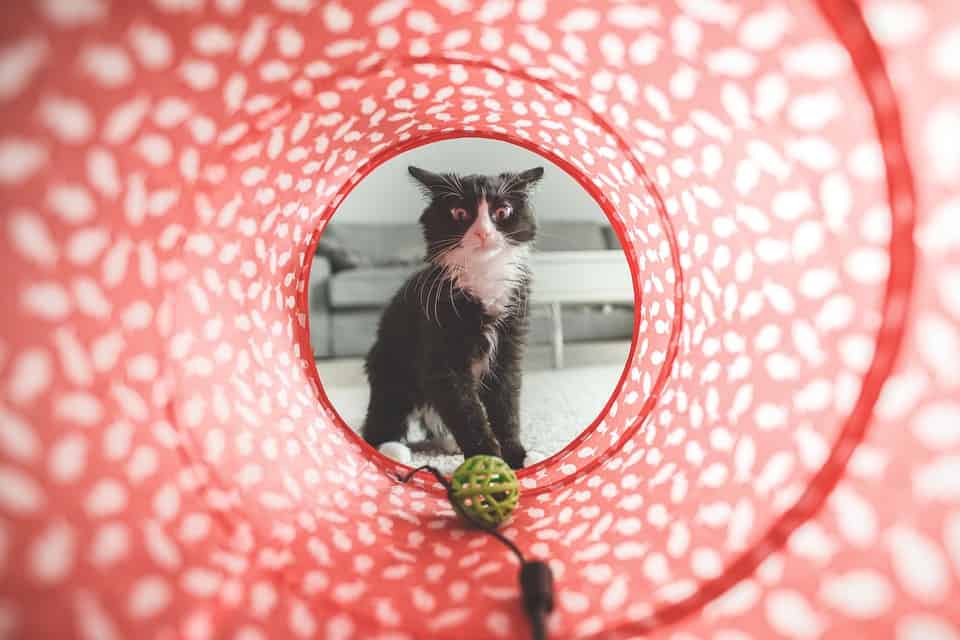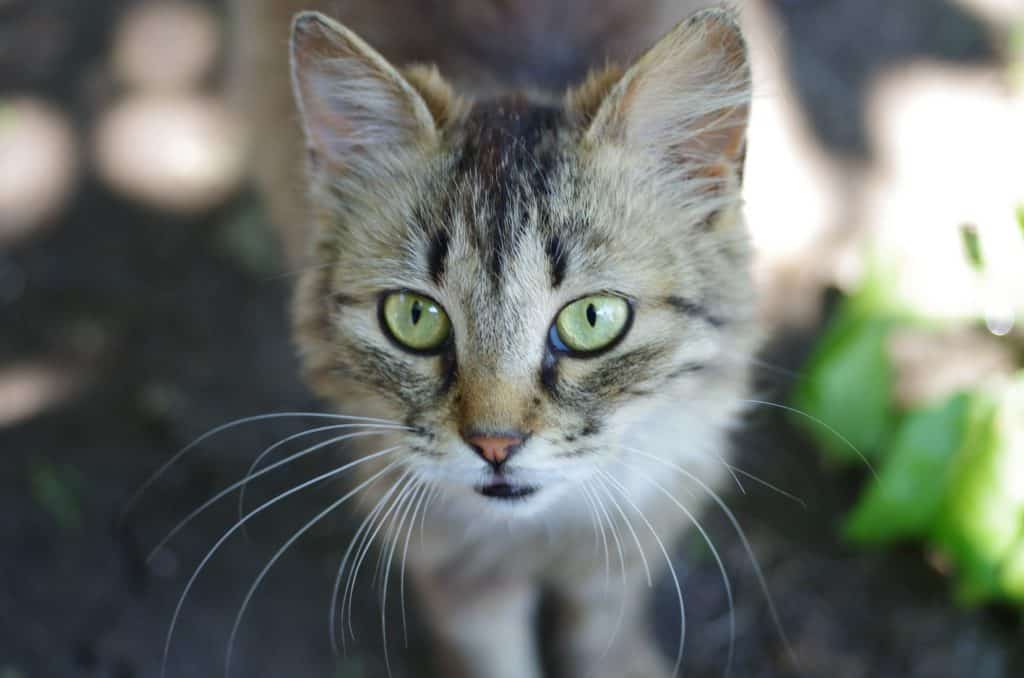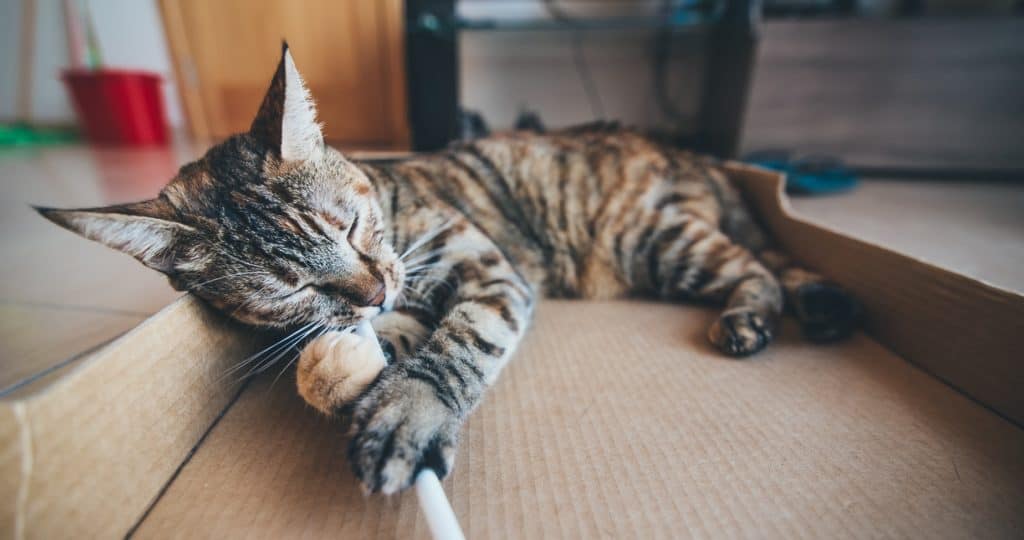Wondering why your cat goes from a peaceful slumber, then ends up zooming around or hyper-playing the next moment? While cats are typically very quiet and reserved, some exhibit hyperactiveness. We must first understand the causes before we can learn how to calm a hyper cat.
Contents
How to Calm a Hyper Cat
Hyper cats tend to be hyperactive because they need to release suppressed energy in their little bodies. To calm a hyper cat, the key is to drain pent-up energy by playing with them and scheduling proper mealtimes. Likewise, we can ensure they get proper grooming and try using calming solutions.
Since hyper cats might have various personalities, medical histories, and households, some ways may work, while others won’t. Explore and see which of these solutions can calm your hyper cats.
Plan Mealtimes
Hyper cats show a burst of energy when they’re hungry. Yet, they also tend to sleep after a big meal. As a cat owner, it would be ideal to schedule their main meals at least one or two hours before going to sleep.

Hold Play Sessions
No matter how serene felines look, they still have lots of energy to spare. For this reason, it would be best to dedicate play sessions around the house at least 20 minutes per day. By structuring playtime, we can reduce hyperactivity and control energy.
We can divide this into two or three play sessions or a single session until your pet completely spends its energy. We can then experiment until we see what works best for the cat.
To help calm our cats, we consider these kinds of toys for playtime:
- Toys they can chase: A piece of string, laser pointers, or wind-up toys.
- Toys they can scratch: Keep your cat’s claws sharp by using a scratching post. Besides, this lets you save precious furniture!
- Toys they can hit: Cats enjoy batting at things that move easily across the floor, like ping-pong balls or a soft ball.
- Toys they can jump onto: Cats love to be up high, so devote a safe in your house space for their climbing needs. In this way, you can also help your cat burn calories.
Address Any Hyperthyroid Issues
About 10% of senior cats screened for hyperthyroidism suffer from the disease. This condition causes them to have an overactive thyroid gland, which controls a cat’s energy levels. Hyperthyroidism makes hyper cats have reduced appetite and lack of sleep, resulting in heightened energy and stress levels.
We can treat this condition through medication, radioactive iodine therapy, or surgical removal of the thyroid gland. Due to this, it’s crucial to understand when your cat is hyper because of hyperthyroidism or just overly active.
Take Your Cat for a Walk
Taking your hyper kitten for a walk is another great way of draining their energy during the day and providing it with an enriched life. While cats aren’t as athletic as dogs, most of them enjoy going outside, seeing or smelling things, and even rolling around in the grass. Walking also prevents cat obesity as it allows your cat to get some exercise and calm down.
You can take your pet to protected cat parks such as Shambala Preserve and Los Angeles Zoo & Botanical Garden or cat-friendly beaches like Asilomar and Seacliff State Beaches.
However; avoid leaving your cat outside alone, especially when it’s not used to strolling on its own because other animals can fight your cat and even injure it.
Get Your Cat a Companion
Although playtime is very crucial, you cannot ignore the daily responsibilities just to play with your cat. To solve this problem, you can get another cat for them to interact and play with. While this is a good idea, keep in mind that getting another cat can be messy.

Talk to Your Cat Calmly
Cats are very intelligent animals. Any cat will respect you if you speak to them calmly. In fact, your character will define your cat’s characteristics. So try to speak to them calmly and understand their body language. A hyper cat’s tail, ears, and eyes can help you interpret its mood.
A high, vertical tail means your cat is confident, happy, and comfortable while a low tail means your cat is anxious or fearful. On the other hand, forward ears indicate a feline that’s engaged, relaxed, alert, or confident while ears turned back indicate your pet is fearful or angry. Their eyes are another great place to check for clues.
When your cat feels comfortable around you and trusts you, it will have relaxed eyes and may blink slowly at you while dilated pupils can mean anger, excitement, or fear. However, dilated and large pupils can also indicate a desire to play. Unlike dogs that show warning by staring and baring teeth, cats arch their back and their hair may lift.
Give Your Cat Its Space
Cats can get hyper because of insecurities and anxiety. When this happens, do not tell them off. Instead, allow them to do their own thing and give them space. During this period, your cat may be more sensitive.
So anything you do like stretching your hand to comfort your cat can get backlashed and make your pet more irritated. The best thing you can do is to continue watching over them until they’ve calmed down.
Another way of giving your hyper cat space is to allow them to stay in a room. Since your cat may make the room their territory, avoid invading it. Instead, provide your cat with essentials such as a cat litter box, cat food, and a comfy blanket.
Don’t Give in to Your Cat’s Bad Behavior
Giving in to your pet’s natural behavior and temperaments can worsen things. Unfortunately, most cat owners make mistakes by doing what their hyper pets want. If your cat keeps pestering you, do not give in because bad behavior can continue into adulthood.
If you allow your cat to do something once, it will do it again and this natural behavior may not change. Instead, train your cat and try to correct their natural behavior. If you continue doing this, they will stop bothering you and eventually calm down over time.
When Is Hyperactivity a Problem?
While hyperactivity can be frustrating for cat owners, it’s a natural behavior for cats. All cats including kittens become hyper at some point. They are nocturnal by nature, which means they’re more active at night than during the day.
Try these tips to help your cat understand that nighttime hours are for sleeping and not playing:
Ensure your feline has no medical problems since an active kitty could be in pain.
Unlike dogs that are very active and playful during the day, cats love sleeping. So if your pet is overly active at night, tire and then feel relaxed with a nice play session before going to bed.
Unlike dogs, cats need to eat frequent meals. So feed your kitty their final meal in the evening since they fall asleep after a big meal.
Enrich your kitty’s environment with a variety of toys or items to explore during the day to make it snooze at night.
However, hyperactivity becomes a problem when it begins affecting your cat’s normal life, making your cat easily get distracted or bored when playing with them or unable to eat or sleep well and causing stress.
When a natural behavior turns into a problem, you should seek professional help. First, you should pay attention to your cat’s behavioral changes, especially if your cat wakes up normally every day in the morning and becomes overly hyper during the day.
Below are signs of an uneasy and stressed cat:
If your cat begins to twitch its tail’s end, it could be a sign that it is beginning to become unhappy. After a while, stress will soon follow.
When your cat is stressed, it will mark its territory by urinating outside the litter box.
When your cat feels insecure and unsafe, they tend to hide. This makes them feel secure as they’re less visible.
It’s also important to book an appointment with me to see if you suspect your hyper cat has any health problems like hyperthyroidism.
What Are The Symptoms of Hyperthyroidism?
The most common sign of hyperthyroidism is weight loss because of the increased metabolism rate. Affected pets may become aggressive and restless. They may also have increased urination and water consumption and display increased vocalizing at night.
Additionally, they may develop occasional diarrhea and vomiting while fur may appear unkempt. Anorexia may also develop as the illness progresses in some felines. When faced with a serious situation, you can use drugs to calm a hyper kitten. However; ensure the drugs are approved by a veterinarian.

Related Questions
How Does a Hyper Pet Look Like?
A hyper pet can exhibit different types of nervous behavior like chasing other pets and humans, compulsive licking, and attracting attention through hitting and mewing.
A hyper cat can also jump between chairs and run around the house. Most hyper kittens usually display this kind of hyperactivity to release suppressed energy.
Can a Dirty Litter Box Cause Distress to a Cat?
Yes, dirty litter boxes can cause distress to a cat and make your cat act out due to being unhappy. Unlike dogs, cats are clean animals naturally, so keep your kitten’s litter boxes clean and wash them often to be safe.
Can a Cat That Can’t Groom Itself Display Bad Behaviors?
A cat that can’t groom itself can display bad behavior because of stress. However, this happens when your pet is unable to clean all areas of its body due to being overweight. If your cat is obese, we’ll need to discuss how to get it back to a healthy weight.
Conclusion
While learning how to calm a cat may be challenging at first, there are many ways we can try. We need to consider your pet’s age, personality, and environment before anything else. If we suspect anything out of the ordinary, it would be best to consult with me.
